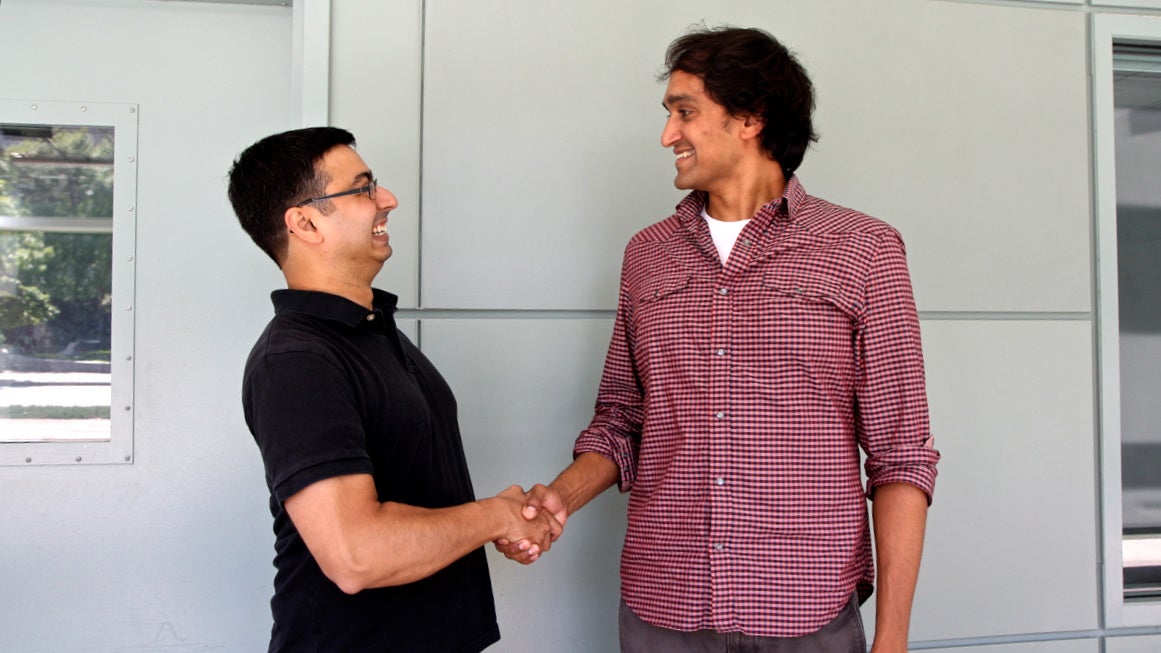Banging galaxies together via simulation is part of the job description
Listen
Science communicator Neil Bardhan (left) meets with Haverford College astronomer Desika Narayanan. (Kimberly Paynter/WHYY)
Imagine looking at amazing space simulations all day long, on a massive computer. Stars exploding, galaxies forming, crashing together. And, this is part of your job!
Haverford College astronomy professor Desika Narayanan studies theoretical galaxy formation and develops large-scale computer simulations to understand how galaxies form from the big bang all the way through today.
He recently came to our studio for our regular series “So, What Do You Do,” which features down to earth conversations about science, and chatted with consultant Neil Bardhan.
“Say I wonder, what happens to a disc galaxy like the milky way, how does it form and evolve. I’ll set up a simulation where you start a sub-section of the universe off, with some of the initial conditions you think may have existed after the big bang,” Narayanan explained about his job.
Bardhan wanted to know what kind of output Narayanan gets once the computer processes his equations. “Do you get numbers, pictures, movies?” he asked.
“You actually get all of these things,” answered Narayanan. “The numbers are useful, but it’s often not as telling as watching the images from different angles, or flying into the image.”
Bardhan also wanted to know if it’s possible to manipulate the output.
Narayanan confirmed that was doable. “For example, the Milky Way is on a crash course with Andromeda, so we might wonder – some billion years from now, what will happen to our solar system. So you can run simulations where you bang two galaxies together and you put in a test particle somewhere where the earth is, and you see what happens to it. And there’s a high probability that we’ll be flung out of the galaxy.”
Bardhan asked Narayanan to explain the most interesting thing he had written about recently. Narayanan said he’s working on some controversial research that revolves around galaxy mergers.
“There is a class of galaxies that lives two to three billion years after the big bang, and you can observe tons of stars forming, tons of light forming everywhere.” Narayanan said these galaxies are much brighter than our own.
“The Milky Way, our galaxy, forms something like one or two suns a year, these galaxies form one or two thousand suns per year, so they are very active places.”
Narayanan said the predominant school of thought on the origin of these bright galaxies is that the light is owed to collisions – galaxies banging together and forming bright stars.
“My collaborators and I we have developed a model where we don’t think they are galaxy mergers, but rather really rich environments, where there are tons and tons of galaxies all smushed into a relatively small area. And that what you are observing is a bunch of galaxies contributing to the light, and not one particular system, and that would in some way re-write the book at this phenomenon that people have been observing for twenty years.”
Bardan asked how this research had been received. “What has been the reaction to this – are people throwing things at you at conferences?” he joked.
“That’s what I say, ‘I give this talk at conferences, and tomatoes hit me in the face'” joked Narayanan.But – he says he enjoys a good debate. “I very much dislike giving a talk at a conference and having everybody say ‘oh yeah, we agree’ that is boring! You want somebody to push back because you want there to be continued problems that get you excited and make you want to work on the problem more!”
WHYY is your source for fact-based, in-depth journalism and information. As a nonprofit organization, we rely on financial support from readers like you. Please give today.




